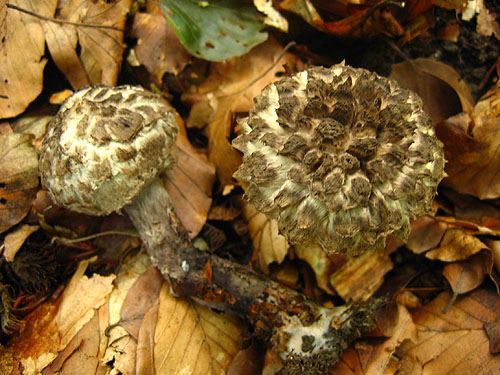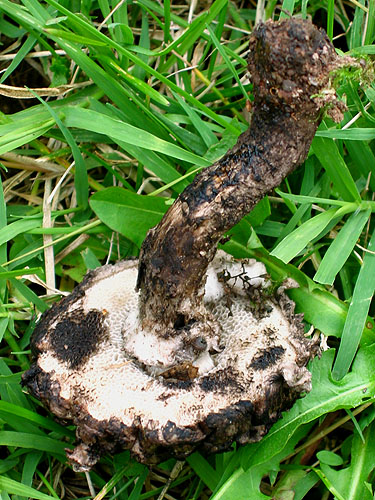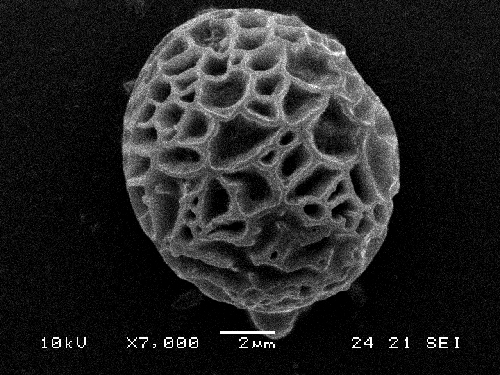Strobilomyces Berk.
The only European member of this otherwise extra-European genus is instantly and easily recognized due to its specific appearance.
Strobilomyces strobilaceus (Scop. : Fr.) Berk.
Description
Fruitbodies with partial veil, quickly disrupting and leaving remnants on the cap margin and fugacious cottony ring in the upper portion of the stipe. Cap up to 10 cm, at first hemispherical then expanding to convex, dark grey with some whitish areas, soon almost entirely black, covered with large black wooly scales; margin overhanging. Stipe more or less cylindrical or club-shaped, almost concolorous with the cap, scaly. Flesh white, almost immediately reddening when exposed to air, then changing to grey-violaceous, grey or almost black. Tubes whitish, reddening when exposed to air. Pores at first whitish, then grayish to almost black, bruising red, then quickly blackening. Smell not distinctive. Taste mild. Spores subglobose, distinctly reticulate, 8.5–14.5 × 7–11 μm.
Habitat. Broadleaf and mixed forests, mycorrhizal with beech (Fagus), oaks (Quercus) or sweet chestnut (Castanea).
Distribution. Widespread throughout Europe, but rare and redlisted in many countries.
Photographs

Fruitbodies of Strobilomyces strobilaceus. (photo B. Assyov)

Strobilomyces strobilaceus. Note the ring and the dramatic change of the flesh colour. (photo B. Assyov)

Strobilomyces strobilaceus. Note the ring and the blackening of the pores. (photo B. Assyov)

Strobilomyces strobilaceus - pores and remnants of the partial veil. (photo B. Assyov)

Spores of Strobilomyces strobilaceus as seen under light microscope. Scale bar = 5 μm. (photo B. Assyov)

Spores of Strobilomyces strobilaceus as seen under scanning electrone microscope. (photo B. Assyov)

Single spore of Strobilomyces strobilaceus under scanning electrone microscope. (photo B. Assyov)
Important literature
Alessio, C.L. 1985. Boletus Dill. ex L. (sensu lato). – In: Fungi Europaei. Vol. 2. Pp. 1–705. Libreria editrice Biella Giovanna, Saronno.
Breitenbach J. & Kränzlin F. 1991. Pilze der Schweiz. Bd. 3(1). Röhrlinge und Blätterpilze. Verlag Mykologia, Luzern.
Estadès, A. & Lannoy, G. 2004. Les bolets européens. – Bulletin Mycologique et Botanique Dauphiné-Savoie 44(3): 3–79.
Galli, R. 1998. I Boleti. Atlante pratico-monographico per la determinazione dei boleti. Edinatura, Milano.
Hansen, L. & Knudsen, H. 1992. Nordic Macromycetes. Vol. 2. Polyporales, Boletales, Agaricales, Russulales. Nordsvamp, Copenhagen.
Knudsen, H. & Vesterholt, J. [eds.]. 2008. Funga Nordica. Nordsvamp, Kopenhagen.
Lannoy, G. & Estadès, A. 2001. Les Bolets. Flore mycologique d’Europe. Documents Mycologiques Mémoire Hors série no. 6. Pp. 1–163. Association d’Écologie et de Mycologie, Lille.
Muñoz, J.A. 2005. Boletus s. l. – In: Fungi Europaei. Vol. 1. Pp. 1–951. Edizioni Candusso, Alassio.
Petersen, R.H., Hughes, K.W., Adamčik, S., Tkalčec, Z. & Mešić, A. 2012. Typification of three European species epithets attributable to Strobilomyces (Boletales). – Czech Mycology 64: 141–163. (available online)
Pilát, A. & Dermek, A. 1974. Hríbovité huby. Československé hríbovité a sliziakovité huby (Boletaceae – Gomphidiaceae). Veda, Bratislava.
Singer, R. 1967. Die Röhrlinge. II. Die Boletoideae und Strobilomycetaceae. – In: Die Pilze Mitteleuropas. Vol. 6. Pp. 1–151. Julius Klinkhardt Verlag, Bad Heilbrunn.
Šutara, J., Mikšík, M. & Janda, V. 2009. Hřibovité houby. Čeled’ Boletaceae a rody Gyrodon, Gyroporus, Boletinus a Suillus. Academia, Praha.
Watling, R. 1970. Boletaceae, Gomphidiaceae, Paxillaceae. – In: Henderson, D.M., Orton, P.D. & Watling, R. [eds]. British fungus flora. Agarics and Boleti. Vol. 1. Royal Botanic Garden, Edinburgh.
Watling, R. & Hills, A.E. 2005. Boletes and their allies (revised and enlarged edition). – In: Henderson, D.M., Orton, P.D. & Watling, R. [eds]. British Fungus Flora. Agarics and boleti. Vol. 1. Royal Botanic Garden, Edinburgh.